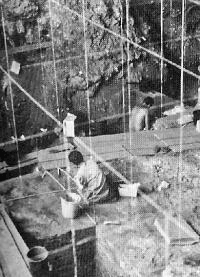Book Review

OFER BAR-YOSEF & LILIANE MEIGNEN (ed.). Kebara Cave, Mt. Carmel, Israel: the Middle and Upper Palaeolithic archaeology. Part I (American School of Prehistoric Research Bulletin 49). xxviii+288 pages, 216 b&w & colour illustrations, 48 tables. 2007. Cambridge (MA): Peabody Museum of Archaeology and Ethnology, Harvard University; 978-0-87365-553-8 paperback. $44.95 & £28.95.
Review by William Davies
Centre for the Archaeology of Human Origins, University of Southampton, UK
(Email: swgd@soton.ac.uk).

Kebara is a key Palaeolithic site, providing a lengthy and detailed record of the transition between Neanderthals and Homo sapiens in the Levant. Although excavation at the site stretches back to 1927, only with the publication of this very substantial monograph (listed as 'volume 1') does this site receive the treatment it deserves. After Turville-Petre's brief but destructive excavation (an estimated 900m³ of upper sediments removed in three months in 1931), Stekelis returned to dig in the 1950s and 1960s (an estimated 600m³ of sediment removed), and finally, Bar-Yosef and colleagues began a series of nine campaigns from the 1980s, which removed about 120m³ of sediment and yielded a celebrated, near-complete Neanderthal skeleton. Little is said of the human remains in this monograph (perhaps they are to be contained in a future volume?), but what is presented is of immense use and importance, and an exemplary model of how to conceive and present a project in an interdisciplinary rather than multidisciplinary manner: all lines of evidence are combined in the chapters, thus building a coherent, broad view of the site and its surroundings. The monograph also aims to integrate the detailed records obtained by the most recent series of excavations with those conducted by Stekelis and Turville-Petre, but in the event, the authors have to admit only moderate success in this enterprise. The material from Turville-Petre is scarcely mentioned, owing to its almost complete lack of stratigraphic control and provenance, but also perhaps because this excavator was generally excavating higher in the stratigraphy than is the concern of this volume. The faunal remains make a point of contact/comparison between the campaigns led by Stekelis and by Bar-Yosef, although the former are considerably less-detailed in their recording and stratigraphic provenances. Nevertheless, Speth and Tchernov (Chapter 9) make sensible and illuminating attempts to match the two sets of records as best they can.
Much emphasis is rightly given to the complex taphonomy of Kebara, and how such studies should be universal at all sites, though they frequently are not. Chapters 1 to 3 set Kebara's materials into their Palaeolithic and excavation context, while Chapters 4 to 7 consider the sediments themselves, from the perspectives of depositional histories, erosion, chemical alteration (including diagenesis of bone), palaeomagnetism (to gain a relative chronology of duration of use of hearths), and the formation and use of the numerous hearths at the site. Chapter 8 is a detailed study of the numerous plant phytoliths left in the deposits (more analyses of the plant remains are promised in volume 2). Chapters 9 and 10 consider the faunal records, including seasonality indicators from cementum increment analyses of ungulate teeth. Most of the above chapters have concerned themselves more with the Neanderthal/Mousterian levels at Kebara than with the overlying Upper Palaeolithic (Homo sapiens?) ones, but that has ensured that the volume is nicely focused. Presumably, many attributes of the site are being saved for future volumes, including a more detailed analysis of the plant remains, the distributions and characteristics of the stone tools, and detailed discussion of the Upper Palaeolithic levels.
For Kebara's Mousterian levels, it is well worth summarising some of the preliminary conclusions reached in volume 1. The theme that emerges most strongly is that of human agency at the site. Having carefully considered the activities of non-human agencies affecting accumulation of sediment (including ash), bone and plant remains, the contributors emphasise the low levels of the latter agencies in many parts of the site: Neanderthals were responsible for bringing much plant material onto the site (wood and bark for fuel, apparently predominating over grass and dicotyledenous leaves), as well as animal carcasses (non-human predators seem to have been more active at the site in the Upper Palaeolithic layers, implying less consistent human occupation then). These patterns are different from many of those seen in other, neighbouring contemporary sites, implying complex variability in Neanderthal behaviours, perhaps related to accessible resources and seasonality. A greater diversity of animal species was exploited in the earlier levels (XIII-IX; c. 60 000-58 000 BP) of the Mousterian than in its upper (VIII-V; c. 57 000-48 000 BP) ones, which show patterning more akin to those seen in the Upper Palaeolithic levels. Speth & Tchernov interpret this patterning as a 'winter-spring base-camp with evidence of intensive large-mammal hunting' in the lower levels, followed by 'predominantly warm-season occupations, with much less evidence of hunting' (pp. 167-8). There was a midden of (mostly ungulate) bones and stone tools along the north wall of the cave, while there is strong evidence for the cooking of tortoises upside-down in their shells in the central floor area of the cave. Neanderthals were not only using many hearths, but were often raking them out after use, leading to extensive distributions of ash remains between the distinct hearths.
All-in-all, this is a very handsomely-produced volume. Well-written and well-illustrated, it is a highly recommended acquisition for the library of anyone interested in the Palaeolithic; it should also be read by those interested in how to excavate such a site and then relate the material recovered to that obtained in earlier, less well-documented excavations.



